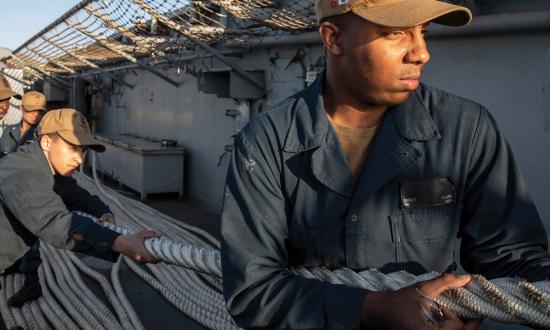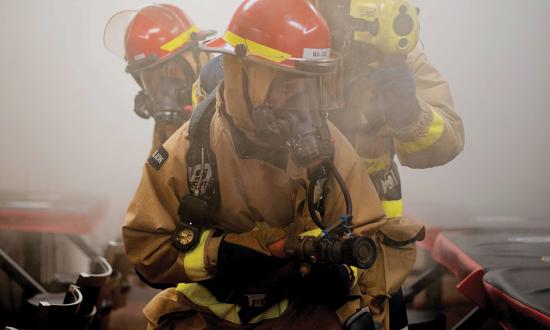Faced with a chronically risk-averse culture coupled with a fiscally conservative environment, it is easy for naval leaders to default to a “lead with no” mindset. Simply put, Navy leaders might be tempted to blame others, pass the buck up the chain of command, and fault both direct and indirect leadership for a lack of time, manpower, and resources to get the job done. This reluctance, hesitancy, and victim mentality not only stifles creativity and innovation, but also prevents leaders from taking ownership. To correct this problem, “Control what you own” has become a mantra for developing units and leaders throughout the fleet. The message is significant but the words are in the wrong order.
Leaders at all levels across warfighting domains need to focus on owning what they control instead of controlling what they own. Naval professionals must look inward and admitting they may not be as good as they can or should be because of a lack of ownership. Leaders must own their ability to control their dedication and discipline in performing the details.
A great example is a group of naval aircrewmen helicopter (AWS) chiefs, senior chiefs, and master chiefs. These senior enlisted helicopter rescue swimmers took it on themselves to create, plan, and execute a joint personnel recovery exercise that included not only 12 squadrons from the Helicopter Sea Combat Wing Atlantic (HSCWL), but also Naval Special Warfare, local fire departments, and the Coast Guard. The helicopter rescue swimmers and search-and-rescue medical technicians identified a critical gap between strategy and skill and set out to close that gap by owning what they control.
Strategy refers to the actions an organization plans in response to or in anticipation of changes in its external environment. Skills are the competencies that reside within the organization. As the Navy adjusts its strategy to meet the challenges of renewed great power competition, it needs to do more than simply state the shift in strategic focus; the need must be met with additional assets and capabilities and by developing superior skills.
The senior enlisted helicopter rescue swimmers and med-techs—determined to own their capabilities and hone their skills—crafted a grassroots training event that focused exclusively on the skills needed to execute maritime personnel recovery operations in both contested and uncontested environments. Using a round-robin format, events were spaced throughout the local area and run simultaneously. Helicopters checked on and off station while ground crews worked the timing between each scenario. The goal was to ensure each crew was confronted with multiple scenarios, demanding the use of several recovery methods and techniques.
The event was coined Tarpon Springs, and during the most recent iteration, helicopter crews experimented with expeditionary air base operations. The team was charged with manning an alert that forced them to bed down in an austere location less than five miles from the coast. They maintained a personnel recovery posture with minimal support personnel, maintenance equipment, and food. After a successful night under the stars, two helicopter crews awoke to a launch order and were able to accomplish the objectives of the training scenario and recover two downed aviators from the Chesapeake Bay. This was the first time HSCWL helicopter crews trained for this specific mission, and it was successful because those involved owned the problem and had the initiative to provide a practical solution.
Also included in the round-robin was the USCGC Frank Drew (WLM-557). Executing a recovery from a non-air-capable ship is a scenario crews will encounter and this skill is perishable. The team cold-called numerous non-air-capable Coast Guard units, and the Frank Drew answered with enthusiasm and flexibility. Helicopter crews hoisted rescue personnel to the Frank Drew’s stern and executed medical assessments, which not only required interservice teamwork and communication, but also challenged crews with complex problems, forcing out-of-the-box thinking in a controlled environment.
To add more complexity to the personnel recovery problem, the senior enlisted planners connected with the Chesapeake federal fire department to establish a mass casualty collection point. Mass casualty collection training not only enhances naval warfighting capability, but also allows search-and-rescue med-techs and swimmers to perform patient assessments and turnovers to civil authorities. These undervalued skills are akin to what service members will experience when conducting humanitarian-assistance or disaster-relief efforts. An experienced rescuer not only can save lives, but also can save time, fuel, and manpower through a proficient turnover.
This is just a quick look at exercise Tarpon Springs. More important, it is a glimpse into the influence of helicopter rescue swimmers as they go beyond the status quo and own what they control. This exercise was coordinated exclusively by senior enlisted leaders. It should inspire leaders at all levels to take an honest look at their individual and unit capabilities.
Every service member can learn from the leaders of Tarpon Springs. Instead of preparing to not lose, leaders must prepare to win. When leaders own what they control, they gain awareness, confidence, and purposefulness. This unleashes the whole team to be more innovative, creative, and useful. Above all, the Navy is more rewarding when service members are good at their jobs, and the nation is more secure when sailors are ready to fight and win!








